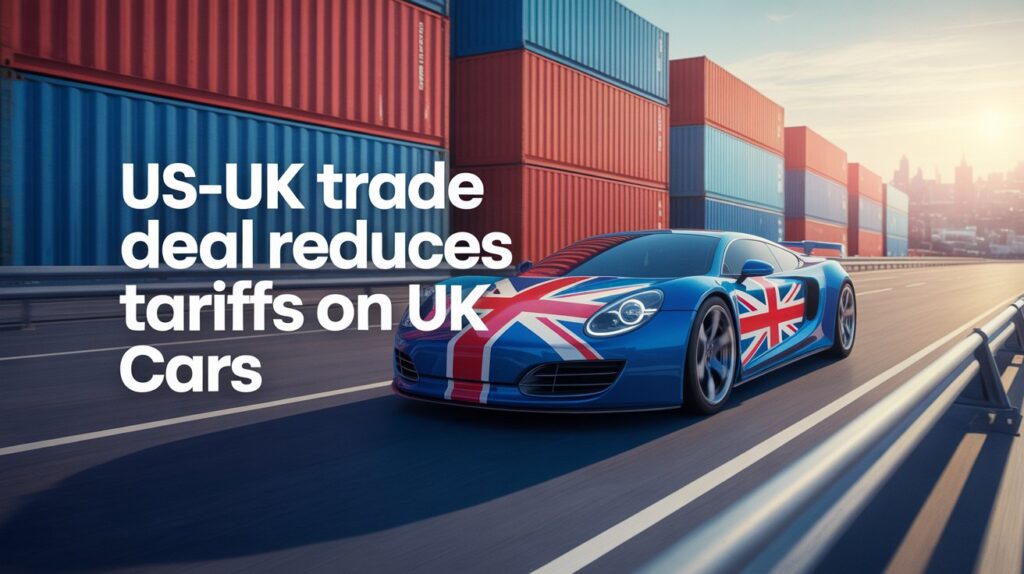Introduction
On May 8, 2025, the United States and United Kingdom sealed a trade deal that’s making waves in the automotive world. The US-UK Trade Deal Reduces Tariffs on UK Cars, cutting import taxes on British cars from 27.5% to 10% for up to 100,000 vehicles annually. This move is a lifeline for UK carmakers like Jaguar Land Rover, but what does it mean for the global market and, more importantly, for us in India? Let’s break it down with a desi twist, exploring how this deal could shake things up, much like a new Maruti Swift hitting the roads.
Details of the US-UK Trade Deal
The US-UK Trade Deal Reduces Tariffs on UK Cars with clear terms: for the first 100,000 cars exported from the UK to the US each year, the tariff drops from a hefty 27.5% to a more manageable 10%. Any cars beyond this quota face a 25% tariff, still lower than before but less generous. This quota covers nearly all UK car exports to the US last year, making it a significant win for British automakers.
Beyond cars, the deal eliminates US tariffs on UK steel and aluminium, previously at 25%, which could lower costs for automotive parts. It also opens US markets for 13,000 metric tonnes of UK beef, though food standards remain intact, avoiding controversies like hormone-fed beef. UK Prime Minister Keir Starmer, speaking from a Jaguar Land Rover factory, called it a “huge and important reduction,” while US President Donald Trump hailed it as a step toward “reciprocal trade” (GOV.UK).
However, the deal isn’t a full free-trade agreement, as Trump lacks Congressional authority for that, unlike the recent India-UK trade deal. Analysts note it’s a “bare bones” agreement, with months of negotiations ahead (BBC News).
Impact on the UK Automotive Industry
For UK carmakers, this deal is like hitting the jackpot in a Diwali lucky draw. Jaguar Land Rover, a major player, could save hundreds of millions annually, boosting production and jobs. The lower tariffs make UK cars more competitive against American brands like Ford or Tesla, potentially increasing exports and market share. This could also lead to price cuts for US consumers, making models like the Range Rover more affordable.
The deal’s timing is critical, as UK automakers faced pressure from Trump’s earlier 10% blanket tariffs on global imports, with cars hit harder at 27.5%. By securing this relief, the UK strengthens its automotive sector, a key economic driver (The Guardian).
Relevance to the Indian Market
Now, let’s talk about what this means for India, where cars like the Maruti Baleno and Hyundai Verna are household names. India exported cars worth $37.11 million to the US in 2023, a small slice of the market, led by companies like Maruti Suzuki and Hyundai (Trading Economics). With UK cars now cheaper in the US, Indian exporters might face tougher competition, but the impact seems limited due to low export volumes.
However, there’s a silver lining. India’s own trade deal with the UK, finalized on May 6, 2025, is a game-changer, slashing tariffs on Indian goods like clothing and boosting bilateral trade by £25.5 billion by 2040 (The Guardian). This shows how trade deals can open doors, much like a new expressway for Indian businesses. If India negotiates similar terms with the US, companies like Tata Motors could see a boost, especially after their struggles to crack the US market.
Global Trade Context
The US-UK Trade Deal Reduces Tariffs on UK Cars amid a stormy global trade climate. Trump’s tariffs, including 25% on foreign autos since April 2025, have rattled markets, with forecasts of 1.8 million fewer vehicle sales in the US and Canada (Reuters). By easing tariffs on UK goods, this deal could inspire other nations to seek similar relief, stabilizing supply chains and prices.
For India, global trade shifts matter. Lower steel tariffs could reduce costs for Indian manufacturers reliant on imports, indirectly benefiting companies like Mahindra. Plus, as global car prices fluctuate, Indian consumers might see more competitive options, much like choosing between a Creta and a Harrier.
Comparative Analysis
Here’s a quick look at the deal’s key aspects and their implications:
| Aspect | Details | Impact |
|---|---|---|
| Tariff on UK Cars | Reduced from 27.5% to 10% for 100,000 cars/year; 25% for additional | Boosts UK exports, saves millions for firms like Jaguar Land Rover |
| Steel and Aluminium Tariffs | Reduced to 0% from 25% | Lowers costs for automotive supply chains, benefits global manufacturers |
| Indian Context | Modest car exports to US ($37M in 2023); recent India-UK deal | Limited direct impact; potential for future India-US trade benefits |
| Global Trade | Amid Trump’s tariff hikes; sets precedent for negotiations | Could stabilize markets, influence prices and competition |
Future Outlook
The US-UK Trade Deal Reduces Tariffs on UK Cars is a step toward stronger economic ties, but it’s not the full story. With details still being finalized, stakeholders in India and beyond should watch for updates. For Indian automakers, the focus remains on leveraging deals like the India-UK agreement while eyeing opportunities in markets like the US. As global trade evolves, such agreements could pave the way for a smoother ride, much like cruising on a newly paved highway.
Conclusion
The US-UK trade deal, announced on May 8, 2025, is a big deal for British carmakers, slashing tariffs and boosting competitiveness. While India’s direct stake is small, the deal highlights the power of trade agreements, as seen in our own UK pact. As the world navigates trade turbulence, this move could spark more collaborations, benefiting economies and consumers alike, from London to Ludhiana.
Key Citations
- Landmark economic deal with United States saves thousands of jobs for British car makers and steel industry
- Cars, steel, beef and films: the key points of the US-UK trade deal
- US and UK agree deal slashing Trump tariffs on cars and metals
- What’s in the US-UK economic deal?
- UK and India agree trade deal after three years of negotiations
- India Exports of motor cars and vehicles to United States



